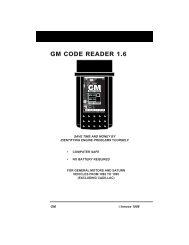Create successful ePaper yourself
Turn your PDF publications into a flip-book with our unique Google optimized e-Paper software.
Onboard Diagnostics<br />
OBD2 MONITORS<br />
into the engine where the vapors are burned. The EVAP Monitor checks<br />
for proper fuel vapor flow to the engine, and pressurizes the system to<br />
test for leaks. The computer runs this Monitor once per trip.<br />
The EVAP Monitor is supported by “spark ignition” vehicles only. The<br />
EVAP Monitor is a “Two-Trip” Monitor. If a fault is found on the first trip,<br />
the computer temporarily saves the fault in its memory as a Pending<br />
Code. The computer does not command the MIL on at this time. If the<br />
fault is sensed again on the second trip, the PCM commands the MIL<br />
“On,” and saves the code in its long-term memory.<br />
Oxygen Sensor Heater Monitor - The Oxygen Sensor Heater<br />
Monitor tests the operation of the oxygen sensor’s heater. There<br />
are two modes of operation on a computer-controlled vehicle: “openloop”<br />
and “closed-loop.” The vehicle operates in open-loop when the<br />
engine is cold, before it reaches normal operating temperature. The<br />
vehicle also goes to open-loop mode at other times, such as heavy load<br />
and full throttle conditions. When the vehicle is running in open-loop, the<br />
oxygen sensor signal is ignored by the computer for air/fuel mixture<br />
corrections. Engine efficiency during open-loop operation is very low,<br />
and results in the production of more vehicle emissions.<br />
Closed-loop operation is the best condition for both vehicle emissions<br />
and vehicle operation. When the vehicle is operating in closed-loop, the<br />
computer uses the oxygen sensor signal for air/fuel mixture corrections.<br />
In order for the computer to enter closed-loop operation, the oxygen<br />
sensor must reach a temperature of at least 600°F. The oxygen sensor<br />
heater helps the oxygen sensor reach and maintain its minimum<br />
operating temperature (600°F) more quickly, to bring the vehicle into<br />
closed-loop operation as soon as possible.<br />
The Oxygen Sensor Heater Monitor is supported by “spark ignition”<br />
vehicles only. The Oxygen Sensor Heater Monitor is a “Two-Trip”<br />
Monitor. If a fault is found on the first trip, the computer temporarily<br />
saves the fault in its memory as a Pending Code. The computer does<br />
not command the MIL on at this time. If the fault is sensed again on the<br />
second trip, the computer commands the MIL “On,” and saves the code<br />
in its long-term memory.<br />
Oxygen Sensor Monitor - The Oxygen Sensor monitors how<br />
much oxygen is in the vehicle’s exhaust. It generates a varying<br />
voltage of up to one volt, based on how much oxygen is in the exhaust<br />
gas, and sends the signal to the computer. The computer uses this<br />
signal to make corrections to the air/fuel mixture. If the exhaust gas has<br />
a large amount of oxygen (a lean air/fuel mixture), the oxygen sensor<br />
generates a “low” voltage signal. If the exhaust gas has very little<br />
oxygen (a rich mixture condition), the oxygen sensor generates a “high”<br />
voltage signal. A 450mV signal indicates the most efficient, and least<br />
polluting, air/fuel ratio of 14.7 parts of air to one part of fuel.<br />
The oxygen sensor must reach a temperature of at least 600-650°F,<br />
and the engine must reach normal operating temperature, for the<br />
computer to enter into closed-loop operation. The oxygen sensor only<br />
functions when the computer is in closed-loop. A properly operating<br />
oxygen sensor reacts quickly to any change in oxygen content in the<br />
OBD2&1 23




